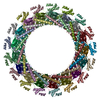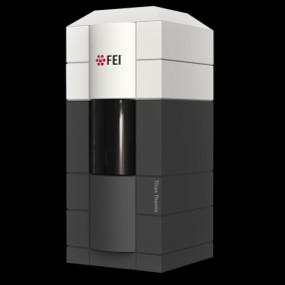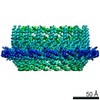[English] 日本語
 Yorodumi
Yorodumi- PDB-6x6j: Cryo-EM Structure of CagX and CagY within the Helicobacter pylori PR -
+ Open data
Open data
- Basic information
Basic information
| Entry | Database: PDB / ID: 6x6j | ||||||||||||||||||||||||
|---|---|---|---|---|---|---|---|---|---|---|---|---|---|---|---|---|---|---|---|---|---|---|---|---|---|
| Title | Cryo-EM Structure of CagX and CagY within the Helicobacter pylori PR | ||||||||||||||||||||||||
 Components Components |
| ||||||||||||||||||||||||
 Keywords Keywords |  PROTEIN TRANSPORT / PROTEIN TRANSPORT /  Helicobacter / Helicobacter /  T4SS / T4SS /  Secretion Secretion | ||||||||||||||||||||||||
| Function / homology |  Function and homology information Function and homology information | ||||||||||||||||||||||||
| Biological species |   Helicobacter pylori (bacteria) Helicobacter pylori (bacteria) | ||||||||||||||||||||||||
| Method |  ELECTRON MICROSCOPY / ELECTRON MICROSCOPY /  single particle reconstruction / single particle reconstruction /  cryo EM / Resolution: 3.5 Å cryo EM / Resolution: 3.5 Å | ||||||||||||||||||||||||
 Authors Authors | Sheedlo, M.J. / Chung, J.M. / Sawhney, N. / Durie, C.L. / Cover, T.L. / Ohi, M.D. / Lacy, D.B. | ||||||||||||||||||||||||
| Funding support |  United States, 7items United States, 7items
| ||||||||||||||||||||||||
 Citation Citation |  Journal: Elife / Year: 2020 Journal: Elife / Year: 2020Title: Cryo-EM reveals species-specific components within the Cag type IV secretion system core complex. Authors: Michael J Sheedlo / Jeong Min Chung / Neha Sawhney / Clarissa L Durie / Timothy L Cover / Melanie D Ohi / D Borden Lacy /  Abstract: The pathogenesis of -associated gastric cancer is dependent on delivery of CagA into host cells through a type IV secretion system (T4SS). The Cag T4SS includes a large membrane-spanning core ...The pathogenesis of -associated gastric cancer is dependent on delivery of CagA into host cells through a type IV secretion system (T4SS). The Cag T4SS includes a large membrane-spanning core complex containing five proteins, organized into an outer membrane cap (OMC), a periplasmic ring (PR) and a stalk. Here, we report cryo-EM reconstructions of a core complex lacking Cag3 and an improved map of the wild-type complex. We define the structures of two unique species-specific components (Cag3 and CagM) and show that Cag3 is structurally similar to CagT. Unexpectedly, components of the OMC are organized in a 1:1:2:2:5 molar ratio (CagY:CagX:CagT:CagM:Cag3). CagX and CagY are components of both the OMC and the PR and bridge the symmetry mismatch between these regions. These results reveal that assembly of the T4SS core complex is dependent on incorporation of interwoven species-specific components. | ||||||||||||||||||||||||
| History |
|
- Structure visualization
Structure visualization
| Movie |
 Movie viewer Movie viewer |
|---|---|
| Structure viewer | Molecule:  Molmil Molmil Jmol/JSmol Jmol/JSmol |
- Downloads & links
Downloads & links
- Download
Download
| PDBx/mmCIF format |  6x6j.cif.gz 6x6j.cif.gz | 1.4 MB | Display |  PDBx/mmCIF format PDBx/mmCIF format |
|---|---|---|---|---|
| PDB format |  pdb6x6j.ent.gz pdb6x6j.ent.gz | Display |  PDB format PDB format | |
| PDBx/mmJSON format |  6x6j.json.gz 6x6j.json.gz | Tree view |  PDBx/mmJSON format PDBx/mmJSON format | |
| Others |  Other downloads Other downloads |
-Validation report
| Arichive directory |  https://data.pdbj.org/pub/pdb/validation_reports/x6/6x6j https://data.pdbj.org/pub/pdb/validation_reports/x6/6x6j ftp://data.pdbj.org/pub/pdb/validation_reports/x6/6x6j ftp://data.pdbj.org/pub/pdb/validation_reports/x6/6x6j | HTTPS FTP |
|---|
-Related structure data
| Related structure data |  6x6kC  6x6lC  6x6sC M: map data used to model this data C: citing same article ( |
|---|---|
| Similar structure data |
- Links
Links
- Assembly
Assembly
| Deposited unit | 
|
|---|---|
| 1 |
|
- Components
Components
| #1: Protein | Mass: 60607.324 Da / Num. of mol.: 17 / Source method: isolated from a natural source Source: (natural)   Helicobacter pylori (strain ATCC 700392 / 26695) (bacteria) Helicobacter pylori (strain ATCC 700392 / 26695) (bacteria)Strain: ATCC 700392 / 26695 / References: UniProt: O25263 #2: Protein | Mass: 219748.641 Da / Num. of mol.: 17 / Source method: isolated from a natural source Source: (natural)   Helicobacter pylori (strain ATCC 700392 / 26695) (bacteria) Helicobacter pylori (strain ATCC 700392 / 26695) (bacteria)Strain: ATCC 700392 / 26695 / References: UniProt: O25262 |
|---|
-Experimental details
-Experiment
| Experiment | Method:  ELECTRON MICROSCOPY ELECTRON MICROSCOPY |
|---|---|
| EM experiment | Aggregation state: PARTICLE / 3D reconstruction method:  single particle reconstruction single particle reconstruction |
- Sample preparation
Sample preparation
| Component | Name: Helicobacter pylori Cag T4SS PR / Type: COMPLEX / Entity ID: all / Source: NATURAL |
|---|---|
| Molecular weight | Experimental value: NO |
| Source (natural) | Organism:   Helicobacter pylori (bacteria) Helicobacter pylori (bacteria) |
| Buffer solution | pH: 7 |
| Specimen | Embedding applied: NO / Shadowing applied: NO / Staining applied : NO / Vitrification applied : NO / Vitrification applied : YES : YES |
Vitrification | Cryogen name: ETHANE |
- Electron microscopy imaging
Electron microscopy imaging
| Experimental equipment |  Model: Titan Krios / Image courtesy: FEI Company |
|---|---|
| Microscopy | Model: FEI TITAN KRIOS |
| Electron gun | Electron source : :  FIELD EMISSION GUN / Accelerating voltage: 300 kV / Illumination mode: FLOOD BEAM FIELD EMISSION GUN / Accelerating voltage: 300 kV / Illumination mode: FLOOD BEAM |
| Electron lens | Mode: BRIGHT FIELD Bright-field microscopy Bright-field microscopy |
| Image recording | Electron dose: 59.2 e/Å2 / Film or detector model: GATAN K2 SUMMIT (4k x 4k) |
- Processing
Processing
| Software |
| ||||||||||||||||||||||||
|---|---|---|---|---|---|---|---|---|---|---|---|---|---|---|---|---|---|---|---|---|---|---|---|---|---|
CTF correction | Type: PHASE FLIPPING AND AMPLITUDE CORRECTION | ||||||||||||||||||||||||
3D reconstruction | Resolution: 3.5 Å / Resolution method: FSC 0.143 CUT-OFF / Num. of particles: 20929 / Symmetry type: POINT | ||||||||||||||||||||||||
| Refinement | Cross valid method: NONE Stereochemistry target values: GeoStd + Monomer Library + CDL v1.2 | ||||||||||||||||||||||||
| Displacement parameters | Biso mean: 95.94 Å2 | ||||||||||||||||||||||||
| Refine LS restraints |
|
 Movie
Movie Controller
Controller












 PDBj
PDBj